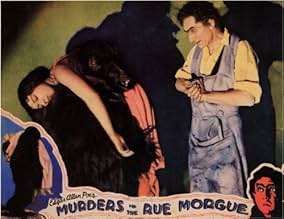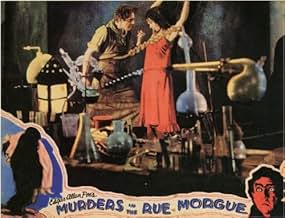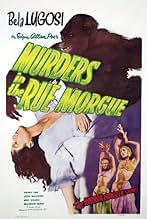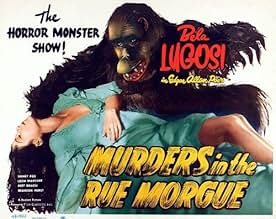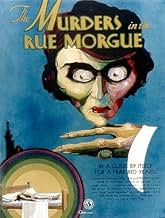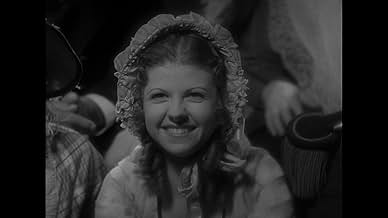NOTE IMDb
6,3/10
5,8 k
MA NOTE
Un savant fou cherche à mélanger le sang humain avec celui d'un singe, et a recours à l'enlèvement de femmes pour ses expériences.Un savant fou cherche à mélanger le sang humain avec celui d'un singe, et a recours à l'enlèvement de femmes pour ses expériences.Un savant fou cherche à mélanger le sang humain avec celui d'un singe, et a recours à l'enlèvement de femmes pour ses expériences.
- Réalisation
- Scénario
- Casting principal
- Récompenses
- 2 victoires au total
Leon Ames
- Pierre Dupin
- (as Leon Waycoff)
Ted Billings
- Sideshow Spectator
- (non crédité)
Herman Bing
- Franz Odenheimer
- (non crédité)
Joe Bonomo
- Gorilla
- (non crédité)
Agostino Borgato
- Alberto Montani
- (non crédité)
Iron Eyes Cody
- Indian at Sideshow
- (non crédité)
Christian J. Frank
- Gendarme Using Snuff
- (non crédité)
Charles Gemora
- Erik, the Gorilla
- (non crédité)
Harrison Greene
- Sideshow Barker
- (non crédité)
Charlotte Henry
- Blonde Girl in Sideshow Audience
- (non crédité)
Avis à la une
The early 1930s was very much a transition period for cinema. Armed with the newly-adopted technology of "talking pictures" and not really knowing what to do with it, many filmmakers stumbled through the first years of the sound era, gradually finding their feet as more and more established and emerging talents demonstrated exactly what could be done with these advanced storytelling tools. 'Murders in the Rue Morgue (1932)' seems to be very much a product of this learning process, and the truth is that the film is marred horribly by poor acting, often-ludicrous dialogue, a shabbily-edited narrative structure and a giant gorilla that switches periodically between a man in a monkey-suit and a real chimpanzee. However, it would be unfair to attribute these problems solely to the era, as many filmmakers were at this time already creating memorable cinema: in terms of the horror genre, James Whale's 'Frankenstein (1931)' and 'The Invisible Man (1933)' both adapted from classic literature today remain remarkable pictures that have lost little of their intelligence and brilliance.
There are two avenues through which 'Murders in the Rue Morgue' retains a certain air of respectability. The cinematography of Karl Freund, a veteran of German Expressionism, makes the film, if little else, visually interesting, and the climactic rooftop chase is vaguely reminiscent of Robert Wiene's 'The Cabinet of Dr. Caligari (1920).' This sequence, not unexpectedly, also calls 'King Kong (1933)' to mind, and I wonder if Cooper and Schoedsack perhaps looked in the direction of this film as inspiration for their final act in New York. One of Freund's gloriously-inspired shots sees the movie camera attached to Sidney Fox's swing, as she oscillates back and forth while in conversation with her boyfriend; just like the virtuoso first-person perspective in Rouben Mamoulian's 'Dr. Jekyll and Mr. Hyde (1931),' this single shot demonstrates an inventiveness uncommon in film-making prior to the 1940s. Without the restrictions of the Production Code, which wouldn't be actively enforced until 1934, Robert Florey sprinkles the story with some moments of unexpected violence, though Universal reportedly enacted their own form of censorship, removing around twenty minutes of footage.
The second component of the film that merits attention is certainly the acting of Hungarian Bela Lugosi, who had recently secured fame as the infamous Count in Tod Browning's 'Dracula (1931).' Though his performance isn't "great," as many have put it, his interpretation of Dr. Mirakle brims with a ghoulish enthusiasm for theatrics, and the overblown portrayal works well with Karl Freund's exaggerated visuals. Lugosi does his very best to maintain our interest in the film, but most of the remaining actors appear to be actively working against him: Leon Ames (credited as Leon Waycoff) is mostly unconvincing in his role as the heroic medical student turned sleuth, and Bert Roach is almost painfully inadequate as the "comic relief" sidekick. Not much is demanded of actress Sidney Fox, but she is suitably pretty and vulnerable to fit the bill, and I did enjoy D'Arcy Corrigan as the gruesome and corrupt morgue-keeper. Charles Gemora, who built an entire career from making a monkey of himself, plays Erik the Gorilla; apparently Universal's orangutans were in short supply.
There are two avenues through which 'Murders in the Rue Morgue' retains a certain air of respectability. The cinematography of Karl Freund, a veteran of German Expressionism, makes the film, if little else, visually interesting, and the climactic rooftop chase is vaguely reminiscent of Robert Wiene's 'The Cabinet of Dr. Caligari (1920).' This sequence, not unexpectedly, also calls 'King Kong (1933)' to mind, and I wonder if Cooper and Schoedsack perhaps looked in the direction of this film as inspiration for their final act in New York. One of Freund's gloriously-inspired shots sees the movie camera attached to Sidney Fox's swing, as she oscillates back and forth while in conversation with her boyfriend; just like the virtuoso first-person perspective in Rouben Mamoulian's 'Dr. Jekyll and Mr. Hyde (1931),' this single shot demonstrates an inventiveness uncommon in film-making prior to the 1940s. Without the restrictions of the Production Code, which wouldn't be actively enforced until 1934, Robert Florey sprinkles the story with some moments of unexpected violence, though Universal reportedly enacted their own form of censorship, removing around twenty minutes of footage.
The second component of the film that merits attention is certainly the acting of Hungarian Bela Lugosi, who had recently secured fame as the infamous Count in Tod Browning's 'Dracula (1931).' Though his performance isn't "great," as many have put it, his interpretation of Dr. Mirakle brims with a ghoulish enthusiasm for theatrics, and the overblown portrayal works well with Karl Freund's exaggerated visuals. Lugosi does his very best to maintain our interest in the film, but most of the remaining actors appear to be actively working against him: Leon Ames (credited as Leon Waycoff) is mostly unconvincing in his role as the heroic medical student turned sleuth, and Bert Roach is almost painfully inadequate as the "comic relief" sidekick. Not much is demanded of actress Sidney Fox, but she is suitably pretty and vulnerable to fit the bill, and I did enjoy D'Arcy Corrigan as the gruesome and corrupt morgue-keeper. Charles Gemora, who built an entire career from making a monkey of himself, plays Erik the Gorilla; apparently Universal's orangutans were in short supply.
Having decided not to do the Frankenstein monster, Bela's next film for Universal was this rather stagey thriller about a demented doctor trying to mix the blood of an ape with a virgin. The story is a bit far-fetched, and Lugosi is as over-the-top as he can get, but for the most part the film is good, solid entertainment. The film is a bit slow, and its has no music in the background. Add to this some stoic acting on the part of the cast as a whole(Lugosi excepted of course)and some frequent, flat direction from Florey(say that a few times quickly). Florey shows flashes of brilliance(many of them coming through the magic of Karl Freund's camerawork) with scenes such as Lugosi's pitch in the carnival tent, Lugosi murdering a street prostitute, and the finale of Paris above ground. Florey is also remarkably mundane in many scenes too, adding little depth to many of the characters as well as not creating enough suspense where always needed. Florey does deliver more often than not, however. This film is a good example of the traditional Universal horror film, as well as vehicle to display the talents of one Bela Lugosi. Look for Arlene Francis(of What's My Line fame) as a prostitute tied to a cross of woodbeams(possibly one of the best sequences in the film).
Murders In The Rue Morgue casts Bela Lugosi as one of the many mad scientists he played in his long career. To make ends meet he has a carnival act, but it's really a blind for some gruesome experiments involving sex. InterSpecies sex that is.
If Charles Darwin is correct and man is related to the other primates than it follows, reasons Bela apes should be looking to mate with man given the proper stimulation. So for his horny gorilla he kidnaps women and injects them with simian blood. In the Paris of 1845 Bela's experiments are working pretty good as his ape is let loose on these injected women and the young women of Paris are in danger. Women of all classes as streetwalker Arlene Francis discovers to her tragic regret.
King Kong never eyed Fay Wray with more lust than Bela's simian had when he was checking out Sidney Fox. In fact King Kong should prove the hypothesis Lugosi was advancing. The climax of Murders At The Rue Morgue is very similar to King Kong with Leon Ames playing the Bruce Cabot part.
Some really great sets and beautiful cinematography are the main attraction of Murders At The Rue Morgue which bares only the slightest resemblance to Edgar Allan Poe's story. Lugosi is fabulously sinister and lustful, he's checking out Fox and the others himself. It's not Dracula for him, but what is?
If Charles Darwin is correct and man is related to the other primates than it follows, reasons Bela apes should be looking to mate with man given the proper stimulation. So for his horny gorilla he kidnaps women and injects them with simian blood. In the Paris of 1845 Bela's experiments are working pretty good as his ape is let loose on these injected women and the young women of Paris are in danger. Women of all classes as streetwalker Arlene Francis discovers to her tragic regret.
King Kong never eyed Fay Wray with more lust than Bela's simian had when he was checking out Sidney Fox. In fact King Kong should prove the hypothesis Lugosi was advancing. The climax of Murders At The Rue Morgue is very similar to King Kong with Leon Ames playing the Bruce Cabot part.
Some really great sets and beautiful cinematography are the main attraction of Murders At The Rue Morgue which bares only the slightest resemblance to Edgar Allan Poe's story. Lugosi is fabulously sinister and lustful, he's checking out Fox and the others himself. It's not Dracula for him, but what is?
"Murders In the Rue Morgue" was Universal's follow up for star Bela Lugosi after the huge success of "Dracula" (1931). He did appear in other films during this period but mostly in minor roles. In fact, in one of the worst career moves of his career, Bela had turned down the role of the monster in "Frankenstein" (1931).
This film made in 1932, two years before the introduction of the infamous Production Code, contains many situations that would have not been allowed under the Production Code. For example, even the suggestion of a liaison between an ape and a woman would have never been allowed and the clear identification of a prostitute likewise. It's probably why this film was not seen for many years.
Lugosi, donning his mad scientist hat, plays the mysterious Dr. Mirakle who works in a carnival sideshow in 1845 Paris. He displays his man-like ape (actually it looks like a full grown chimpanzee) Erik while searching for a human female to presumably mate with the monster. One night pretty Camille L'Espanaye (Sidney Fox) and her beau, medical student Pierre Dupin (Leon Waycoff) visit the carnival and take in Dr. Mirakle's show. During the show, the ape is give the girl's bonnet and becomes obsessed with her.
Meanwhile we learn that Mirakle has been searching for the right blood match for his pet. We discover that two women have been murdered (offscreen) already. One dark night, Mirakle comes upon a "woman of the streets" (Arlene Francis) who has just witnessed the deaths of two "suitors" in a knife fight. The good doctor lures the poor wench to his laboratory where we witness his torture of her and her rather cold disposition of her corpse when she dies after she is injected with the ape's blood.
All the while Mirakle has kept his eye on the comely Camille. Then one night he sends the ape to Camille's room and..............
The film is well directed by Robert Florey who utilizes Universal's dark fog filled sets to great effect. Lugosi is quite terrifying in this role. Although he did get teamed with Boris Karloff in the mid thirties, he never achieved the heights he should have at Universal. With his personal off screen problems well documented, he made a number of poor choices in his movie roles. During the period when his star should have been rising he kept appearing in cheap poverty row features and serials which did little to advance his career.
Others in the cast include Bert Roach as Paul, Pierre's friend, Brandon Hurst as the Prefect of Police and D'Arcy Corrigan as the Morgue Keeper.
A very young John Huston contributes some additional dialog for the story. Leon Waycoff became Leon Ames and enjoyed a lengthy career as a character actor.
One of Lugosi's best.
This film made in 1932, two years before the introduction of the infamous Production Code, contains many situations that would have not been allowed under the Production Code. For example, even the suggestion of a liaison between an ape and a woman would have never been allowed and the clear identification of a prostitute likewise. It's probably why this film was not seen for many years.
Lugosi, donning his mad scientist hat, plays the mysterious Dr. Mirakle who works in a carnival sideshow in 1845 Paris. He displays his man-like ape (actually it looks like a full grown chimpanzee) Erik while searching for a human female to presumably mate with the monster. One night pretty Camille L'Espanaye (Sidney Fox) and her beau, medical student Pierre Dupin (Leon Waycoff) visit the carnival and take in Dr. Mirakle's show. During the show, the ape is give the girl's bonnet and becomes obsessed with her.
Meanwhile we learn that Mirakle has been searching for the right blood match for his pet. We discover that two women have been murdered (offscreen) already. One dark night, Mirakle comes upon a "woman of the streets" (Arlene Francis) who has just witnessed the deaths of two "suitors" in a knife fight. The good doctor lures the poor wench to his laboratory where we witness his torture of her and her rather cold disposition of her corpse when she dies after she is injected with the ape's blood.
All the while Mirakle has kept his eye on the comely Camille. Then one night he sends the ape to Camille's room and..............
The film is well directed by Robert Florey who utilizes Universal's dark fog filled sets to great effect. Lugosi is quite terrifying in this role. Although he did get teamed with Boris Karloff in the mid thirties, he never achieved the heights he should have at Universal. With his personal off screen problems well documented, he made a number of poor choices in his movie roles. During the period when his star should have been rising he kept appearing in cheap poverty row features and serials which did little to advance his career.
Others in the cast include Bert Roach as Paul, Pierre's friend, Brandon Hurst as the Prefect of Police and D'Arcy Corrigan as the Morgue Keeper.
A very young John Huston contributes some additional dialog for the story. Leon Waycoff became Leon Ames and enjoyed a lengthy career as a character actor.
One of Lugosi's best.
Much creepier than any mad scientist and his monkey movie has a right to be. Much of the credit must go to cinematographer Karl Freund (The Last Laugh, Metropolis) who gives the movie the feel of a German horror film. Charles D. Hall's distorted sets also help make this often resemble a sound remake of "The Cabinet Of Dr. Caligari." The script has a very European flavor as well with lines that sometimes sound as if they were translated from another language. The ape is more convincing than all those later films because of quick cutting between an actual ape's snarling face and a man in a suit, the latter shown not enough to destroy the illusion. At one point stop motion is used to show the ape carrying a woman across the top of buildings a year before "King Kong!" There are three failings, however. Near the end is a long attempt at humor concerning French bureaucracy that hurts the build-up of tension. The other two failings come from the lab. They lay over one sequence a fog effect with the fog blowing at hurricane strength despite no apparent wind anywhere else in the shot. And at the end is a very obvious matte shot with lots of squiggly lines around the characters.
Le saviez-vous
- AnecdotesMany censors cut parts of the death scenes of the woman (Arlene Francis) of the streets - eliminating her stabbing and being tied to the cross beams.
- GaffesIn many scenes, the close-up of a chimpanzee is used for the gorilla.
- Citations
Dr. Mirakle: [Responding to an audience member who has accused him of heresy] Heresy? Do they still burn men for heresy? Then burn me monsieur, light the fire! Do you think your little candle will outshine the flame of truth?
- Crédits fousAt the end of the film, the cast list is shown again with the heading, "A GOOD CAST IS WORTH REPEATING...."
- Versions alternativesWhen originally released theatrically in the UK, the BBFC made cuts to secure a 'A' rating. All cuts were waived in 2001 when the film was granted a '12' certificate for home video.
- ConnexionsEdited into Mondo Lugosi - A Vampire's Scrapbook (1987)
Meilleurs choix
Connectez-vous pour évaluer et suivre la liste de favoris afin de recevoir des recommandations personnalisées
Détails
- Date de sortie
- Pays d’origine
- Langues
- Aussi connu sous le nom de
- Murders in the Rue Morgue
- Lieux de tournage
- Société de production
- Voir plus de crédits d'entreprise sur IMDbPro
Box-office
- Budget
- 190 000 $US (estimé)
- Durée
- 1h 1min(61 min)
- Couleur
- Rapport de forme
- 1.37 : 1
Contribuer à cette page
Suggérer une modification ou ajouter du contenu manquant


